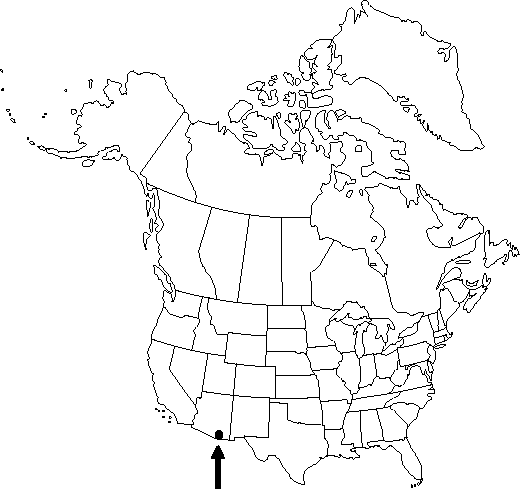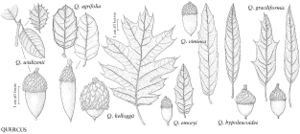Difference between revisions of "Quercus viminea"
Mem. Natl. Acad. Sci. 20: 123, plate 222. 1924.
FNA>Volume Importer |
imported>Volume Importer |
||
| (6 intermediate revisions by 2 users not shown) | |||
| Line 9: | Line 9: | ||
|special_status={{Treatment/ID/Special_status | |special_status={{Treatment/ID/Special_status | ||
|code=F | |code=F | ||
| − | |label= | + | |label=Illustrated |
}} | }} | ||
|basionyms= | |basionyms= | ||
| Line 28: | Line 28: | ||
|distribution=Ariz.;Mexico (Chihuahua;Sonora;and southward). | |distribution=Ariz.;Mexico (Chihuahua;Sonora;and southward). | ||
|discussion=<p>As with many of the Madrean counterparts of the oak flora, in very dry years trees progressively lose their leaves through the long dry spring and may become virtually leafless by the time the rains come in early summer (R. W. Spellenberg, pers. comm.).</p><!-- | |discussion=<p>As with many of the Madrean counterparts of the oak flora, in very dry years trees progressively lose their leaves through the long dry spring and may become virtually leafless by the time the rains come in early summer (R. W. Spellenberg, pers. comm.).</p><!-- | ||
| − | --><p>In the flora, Quercus viminea is known from a single sterile specimen collected at Red Mountain, Santa Cruz County, Arizona. Recent attempts to find the taxon at this site have been fruitless. The Arizona specimen is similar to specimens from northern Mexico that have small, usually entire, narrowly lanceolate leaves with short petioles. These northern forms appear to grade clinally into larger-leaved southern forms that fit the general description of Q. bolanyosensis Trelease.</p> | + | --><p>In the flora, <i>Quercus viminea</i> is known from a single sterile specimen collected at Red Mountain, Santa Cruz County, Arizona. Recent attempts to find the taxon at this site have been fruitless. The Arizona specimen is similar to specimens from northern Mexico that have small, usually entire, narrowly lanceolate leaves with short petioles. These northern forms appear to grade clinally into larger-leaved southern forms that fit the general description of Q. bolanyosensis Trelease.</p> |
|tables= | |tables= | ||
|references= | |references= | ||
| Line 37: | Line 37: | ||
-->{{#Taxon: | -->{{#Taxon: | ||
name=Quercus viminea | name=Quercus viminea | ||
| − | |||
|authority=Trelease | |authority=Trelease | ||
|rank=species | |rank=species | ||
| Line 51: | Line 50: | ||
|publication title=Mem. Natl. Acad. Sci. | |publication title=Mem. Natl. Acad. Sci. | ||
|publication year=1924 | |publication year=1924 | ||
| − | |special status= | + | |special status=Illustrated |
| − | |source xml=https:// | + | |source xml=https://bitbucket.org/aafc-mbb/fna-data-curation/src/2e0870ddd59836b60bcf96646a41e87ea5a5943a/coarse_grained_fna_xml/V3/V3_911.xml |
|genus=Quercus | |genus=Quercus | ||
|section=Quercus sect. Lobatae | |section=Quercus sect. Lobatae | ||
Latest revision as of 21:52, 5 November 2020
Trees, evergreen or drought-deciduous, to 10 m. Twigs brown to dark reddish brown, 2-3 mm diam., sparsely to uniformly pubescent. Terminal buds brown to reddish brown, acutely ovoid, 1.5-2.5 mm, glabrous. Leaves: petiole 2-5 mm, pubescent. Leaf blade narrowly lanceolate, widest at or proximal to middle, 35-60[-150] × 7-10 mm, base usually rounded or obtuse, often oblique, occasionally somewhat cordate, margins entire with 1 apical awn, apex acute to acuminate; surfaces abaxially glabrous or with prominent tufts of tomentum near base of blade, adaxially glabrous or with pubescence along midrib and scattered on blade. Acorns (not known within our range) biennial; cup cup-shaped, 5-8 mm high × 8-10 mm wide, covering ca. 1/3 nut, inner surface pubescent, scales with appressed, obtuse tips; nut ovoid, 9-15 × 7-10 mm.
Phenology: Flowering spring or summer.
Habitat: Habitat not specified
Elevation: 1500 m
Distribution

Ariz., Mexico (Chihuahua, Sonora, and southward).
Discussion
As with many of the Madrean counterparts of the oak flora, in very dry years trees progressively lose their leaves through the long dry spring and may become virtually leafless by the time the rains come in early summer (R. W. Spellenberg, pers. comm.).
In the flora, Quercus viminea is known from a single sterile specimen collected at Red Mountain, Santa Cruz County, Arizona. Recent attempts to find the taxon at this site have been fruitless. The Arizona specimen is similar to specimens from northern Mexico that have small, usually entire, narrowly lanceolate leaves with short petioles. These northern forms appear to grade clinally into larger-leaved southern forms that fit the general description of Q. bolanyosensis Trelease.
Selected References
None.
